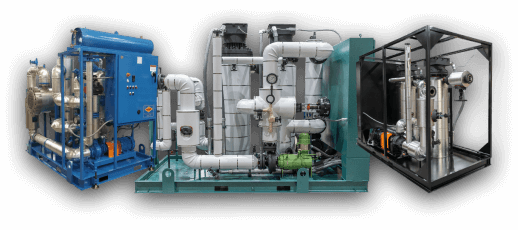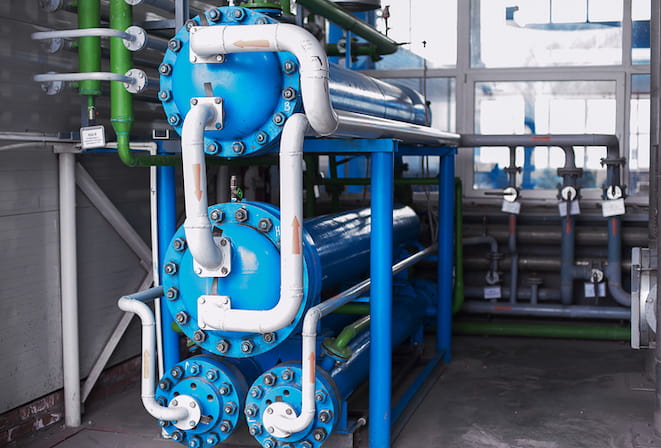The Duty of Heat Transfer Solutions in Sustainable Energy Solutions for the Future
Heat transfer systems are important in the mission for sustainable power options. They enhance thermal energy management, enhancing the performance of sustainable innovations. By utilizing mechanisms like convection, radiation, and transmission, these systems decrease power losses. Their function in solar thermal and geothermal applications is particularly significant. As technologies arise, the capacity for more developments raises vital concerns about future power approaches. What growths will shape the landscape of sustainable power?
Understanding Heat Transfer Systems

The Significance of Thermal Energy Management
Efficient thermal power management is important for optimizing power performance and minimizing waste in different systems. By managing temperature and enhancing Heat transfer procedures, organizations can considerably lower energy usage and functional prices. Effective administration entails the implementation of advanced modern technologies and techniques that keep an eye on and control thermal conditions within systems, making certain that energy resources are used successfully. Furthermore, correct thermal power management contributes to minimizing greenhouse gas exhausts, aligning with global sustainability goals. It likewise improves system dependability and efficiency, bring about enhanced item top quality and longer tools life-span. Eventually, focusing on thermal energy administration is an important action towards producing extra lasting power remedies and cultivating a responsible approach to power intake in residential and commercial contexts.
Applications of Heat Transfer in Renewable Power
While different renewable resource sources promise sustainability, the reliable application of Heat transfer plays a crucial role in their efficiency. In wind energy systems, Heat transfer is made use of for generator element air conditioning, enhancing efficiency and durability. Geothermal energy counts on reliable Heat exchange in between the planet's subsurface and the liquid circulating in the system, optimizing power removal. Biomass power procedures also benefit from Heat transfer, as it assists in converting organic products into functional fuel through pyrolysis and gasification. In addition, in hydropower, preserving excellent temperature levels in tanks can enhance energy result. Each of these applications demonstrates the crucial relevance of Heat transfer systems in enhancing renewable resource innovations, eventually adding to an extra sustainable power future.
Enhancing Solar Thermal Power Effectiveness
As solar thermal power systems remain to evolve, boosting their efficiency has actually come to be necessary for making the most of power outcome. Developments in Heat transfer modern technologies, such as enhanced thermal storage materials and innovative Heat exchangers, play a substantial duty in improving performance. By using innovative products that have exceptional thermal conductivity, systems can record and transfer Heat better. Furthermore, incorporating monitoring systems that follow the sunlight's course warranties that collectors get optimal solar direct exposure throughout the day. Using nanotechnology in solar absorbers can further increase power absorption prices. Integrating automated control systems aids manage temperature levels and take care of energy circulation effectively, leading to lowered losses and enhanced overall system efficiency. These enhancements lead the way for even more sustainable solar thermal energy solutions in the future.
Geothermal Heating: A Lasting Remedy
Geothermal home heating presents a feasible choice for lasting power, providing considerable environmental advantages via lowered greenhouse gas exhausts. Its effectiveness and cost-effectiveness make it an appealing choice to standard heating systems. However, challenges associated with application should be resolved to maximize its prospective influence.
Ecological Benefits of Geothermal
Conventional home heating approaches add substantially to greenhouse gas discharges, geothermal home heating offers a compelling alternative that lessens environmental effect. By utilizing the Planet's internal Heat, geothermal systems make use of a renewable resource resource, significantly decreasing dependence on fossil fuels. This technique generates very little carbon exhausts, making it a cleaner option for domestic and commercial heating. Additionally, geothermal systems promote energy effectiveness, as they call for much less energy compared to traditional furnace. DVS Heat Transfer Systems. The usage of visit our website geothermal energy additionally helps in decreasing air contamination, enhancing neighborhood air quality and public health. As a sustainable service, geothermal heating supports environment adjustment reduction initiatives, positioning itself as a vital part in the shift in the direction of a greener future
Performance and Cost-Effectiveness
How does geothermal home heating measure up in regards to effectiveness and cost-effectiveness compared to traditional heating unit? Geothermal home heating shows remarkable efficiency, typically accomplishing a coefficient of performance (POLICE) of 3 to 5, meaning it generates 3 to 5 units of Heat for every system of electrical power taken in. This performance translates into reduced operating costs, specifically in regions with stable geothermal resources. Preliminary setup prices can be more than standard systems; nevertheless, long-lasting anchor financial savings on power expenses and minimized maintenance expenditures can balance out these ahead of time financial investments. Additionally, lots of governments incentivize geothermal systems via rebates and tax credit scores, improving their cost-effectiveness. Overall, geothermal home heating emerges as a financially feasible and lasting choice to more standard heating solutions.
Execution Obstacles and Solutions
Many challenges can restrain the extensive execution of geothermal heating unit, in spite of their clear advantages as a sustainable energy solution. High preliminary installation prices usually hinder financiers and homeowners, making financing a significant obstacle. Furthermore, the geographical constraints of ideal geothermal sites restrict accessibility in particular areas. Regional laws and allowing procedures can likewise complicate job advancement, bring about delays. Public awareness and understanding of geothermal systems stay reduced, hindering approval. To attend to these obstacles, targeted education projects can improve public expertise, while government incentives can relieve monetary burdens. Working together with neighborhood authorities to streamline regulations might facilitate smoother task authorizations, inevitably promoting the adoption of geothermal home heating as a practical, sustainable energy alternative.
Innovations in Heat Transfer Technologies
Innovations in Heat transfer modern technologies play a crucial role in boosting power performance and sustainability. Advanced Heat exchangers and phase change products are at the leading edge of these advancements, providing substantial enhancements in thermal administration. These modern technologies not only maximize energy usage but likewise add to minimizing environmental impact in various applications.
Advanced Heat Exchangers
Advanced Heat exchangers play a vital duty in improving power performance across various applications in lasting energy solutions. These devices assist in the transfer of Heat between 2 or even more fluids, considerably decreasing power intake in processes such as commercial home heating, air conditioning, and power generation. Developments in materials and layout, such as the usage of nanofluids and portable configurations, have actually led to boosted thermal efficiency and decreased dimension demands. In addition, innovations in electronic tracking and control systems enable enhanced procedure, more boosting performance. By decreasing waste Heat and making best use of energy recovery, check this progressed Heat exchangers add to lower carbon footprints and sustain the change towards eco-friendly technologies. Their continued development is crucial for attaining global energy sustainability objectives.
Stage Change Products
The combination of phase change materials (PCMs) right into Heat transfer modern technologies stands for a significant improvement in energy monitoring and effectiveness. PCMs take in and launch thermal energy during their stage changes, enabling effective temperature guideline in building materials and power systems. By keeping excess Heat during height periods and launching it when need rises, PCMs add to pack changing and energy preservation - DVS Heat Transfer Systems. This ability improves the efficiency of renewable resource systems, especially in solar thermal applications. Furthermore, PCMs can enhance the thermal convenience of interior settings, decreasing reliance on standard home heating and cooling approaches. As developments in PCM formulas proceed to emerge, their duty in sustainable energy services is positioned to grow, using appealing opportunities for future research study and application

Future Potential Customers for Heat Transfer in Sustainable Energy
As the need for sustainable power remedies remains to climb, the role of Heat transfer systems is ending up being progressively important fit future modern technologies. Innovations in designs and materials are anticipated to boost effectiveness in Heat transfer, lowering energy losses in various applications. The integration of sophisticated thermal storage systems, such as phase modification products and thermochemical storage space, will certainly make it possible for much better administration of energy resources. Research into nanofluids and biomimetic Heat exchangers might better maximize thermal efficiency. Furthermore, the adoption of smart technologies will enable real-time monitoring and adaptive control of Heat transfer processes. These improvements are positioned to substantially add to the total performance and sustainability of energy systems, paving the method for a more energy-efficient future.
Regularly Asked Inquiries
Exactly How Can Individuals Execute Heat Transfer Systems at Home?

People can apply Heat transfer systems in your home by installing energy-efficient devices, using radiant heat, and maximizing insulation. These steps enhance energy efficiency, lower costs, and advertise lasting practices in household atmospheres.

What Are the Prices Related To Installing Heat Transfer Equipments?
The expenses related to installing Heat transfer systems differ commonly, typically including devices, installment labor, and upkeep. Variables such as system type, home size, and local policies considerably influence the general expenditure included.
Are There Government Motivations for Heat Transfer System Installations?
Federal government rewards for Heat transfer system installments differ by region and can include tax obligation rebates, credit ratings, and gives. These economic benefits intend to encourage fostering, eventually advertising energy effectiveness and lowering environmental effect within areas.
Just How Do Heat Transfer Solutions Impact Energy Expenses?
Heat transfer systems significantly affect power expenses by maximizing energy efficiency. By improving the transfer of Heat, these systems minimize energy consumption, resulting in reduced utility prices and developing a more lasting method to power management.
What Upkeep Is Required for Heat Transfer Solutions?
Maintenance for Heat transfer systems includes regular inspections, cleaning of parts, examining fluid degrees, ensuring appropriate insulation, and changing worn parts. These tasks help preserve performance, avoid failures, and prolong the system's operational life expectancy.
These systems facilitate the movement of thermal power from one tool to another, enabling the transfer of Heat for cooling, energy, or heating generation purposes. Geothermal energy depends on efficient Heat exchange in between the planet's subsurface and the fluid circulating in the system, making the most of energy removal. Furthermore, geothermal systems advertise power performance, as they require much less energy contrasted to traditional heating systems. Advanced Heat exchangers play a necessary duty in boosting power efficiency across various applications in lasting power services. Heat transfer systems notably influence power bills by enhancing power performance.